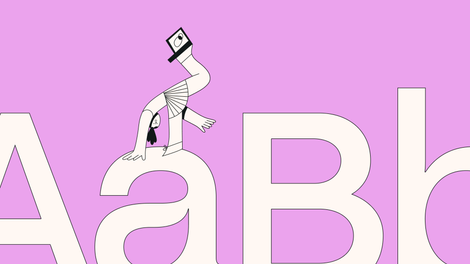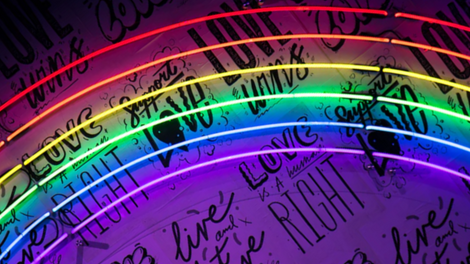As creators in the graphic design space, we at Linearity understand that your choice of design tool can make a significant difference in your creative workflow.
Traditional desktop graphic design tools used to be your only option. But the market has opened up to more agile creative hardware options like the iPad. This guide is designed to help you navigate this evolution.
We'll compare the various iPad and MacBook models for professional design, highlighting their respective strengths and limitations.
Senior designers looking to switch to mobile or graphic designers starting out and comparing devices, this guide's for you.
Jumpstart your ideas with Linearity Curve
Take your designs to the next level.
4 designer opinions on iPad Pro vs MacBook Pro
The iPad Pro offers a direct, tactile experience with its touch interface, ideal for sketching and conceptualizing on the move. Its portability means you can capture inspiration whenever and wherever it strikes.
See one of our iPad video tutorials below to get an idea of what it's like to do graphic design on an iPad:
But the MacBook Pro bears robust computing power, essential for handling complex and layered design tasks. With its high-performance processors and advanced graphics, it's built to manage large files and intricate software with ease.
A MacBook laptop also offers a more extensive range of professional design software, making it a versatile choice for designers who require sophisticated tools for detailed work.
Ready to create brand assets that pack a punch?
Visit our Academy for free marketing design courses.
Each device caters to different stages of the design workflow. The iPad excels in the early stages of design, offering a fluid and intuitive creative experience. Meanwhile, the MacBook is a powerhouse for the later stages, where rendering, editing, and finalizing complex projects come into play.
Ultimately, the decision between the iPad Pro and MacBook Pro comes down to your personal workflow.
If your design work benefits from on-the-go flexibility and a hands-on approach, the iPad Pro is a compelling choice. If you require extensive software capabilities and processing power for intricate designs, then you probably want a MacBook Pro.
But let's see what other professional designers say about their device preferences.
Igor Viveiros, Product Manager at Linearity
Igor's experience includes working as a Visual and UX Designer for some well-known brands in Germany. He started out as a UX Designer at Linearity in 2020 and has been our Product Manager for over three years.
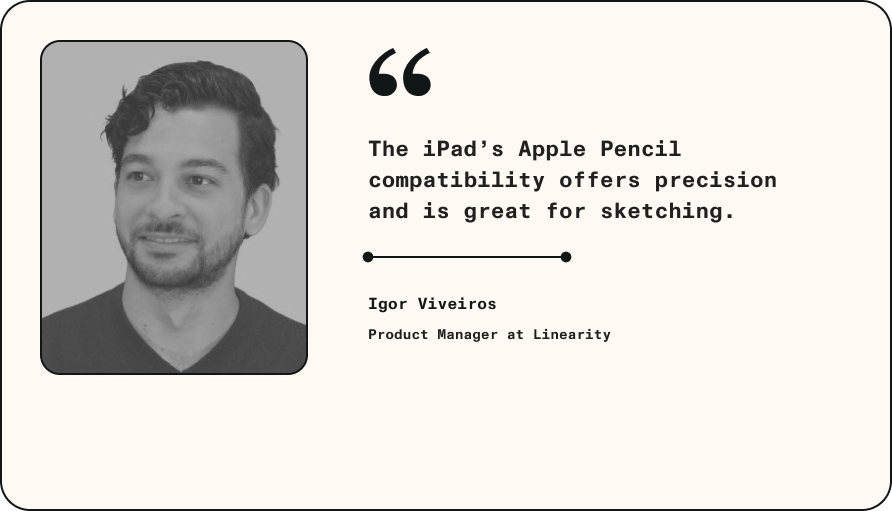
Let's look at Igor's list of pros and cons, comparing iPad Pro with MacBook Pro.
iPad Pro pros:
- Mobility: iPads are portable and hand-held devices.
- Apple Pencil compatibility offers precision and is great for sketching.
- Great software available on the Apple App Store with a touch-first experience.
iPad Pro cons:
- Software limitations: many iPad apps don't run the full version with the full functionalities available in desktop versions.
- File management: not as easy and flexible as on a MacBook or desktop computer.
- Multi-tasking on iPad is less efficient, especially if you're considering a multi-monitor setup.
MacBook Pro pros:
- Powerful hardware.
- Larger screen.
- Better connectivity: you can connect external hard drives, external monitors, and drawing tablets.
- The trackpad with gesture controls is easy and efficient to use.
MacBook Pro cons:
- Less suitable for drawing, especially without an extra device like a drawing tablet.
Sandra Grabowska-Lampa, Design Assistant at Linearity
Sandra is an experienced graphic designer helping Linearity build an inspiring and easy-to-use Template Library.
She shares her iPad and MacBook pros and cons for graphic design.
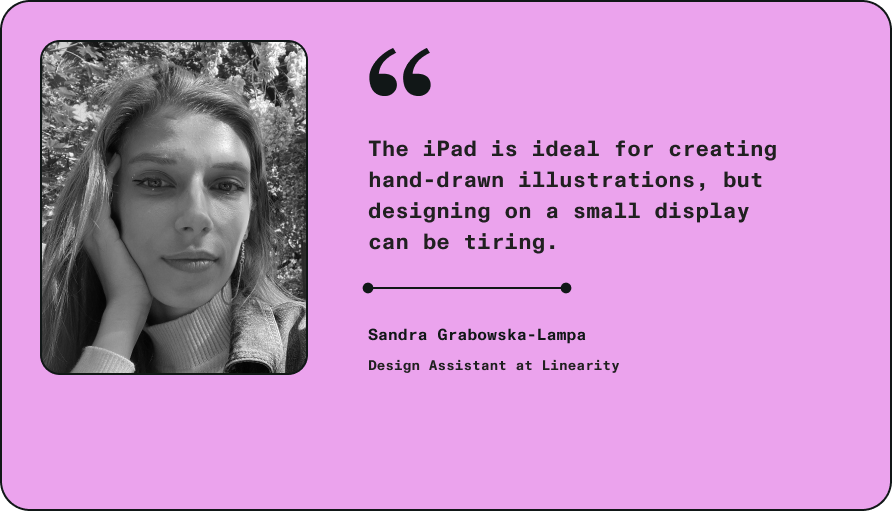
iPad Pro pros:
- Ideal for hand-drawn illustrations.
- Extremely useful for sketching ideas (e.g., logos).
- Highly portable.
iPad Pro cons:
- Designing on a small display can be tiring.
- Limited app selection.
- Older iPads may not work well when connected to external displays via cable.
- Limited memory impacts multitasking and advanced design capabilities.
MacBook Pro pros:
- Large display
- Access to a wide range of professional design software.
- Can be connected to larger monitors for enhanced productivity.
- Better hardware capabilities.
MacBook Pro cons:
- Heavier to carry around.
- Limited upgrade options (e.g., RAM, storage, disk size).
Oleksandra Boiovych, Product Designer at Linearity
Having joined the Linearity team in 2022, Oleksandra is a Product Designer with a background in graphic design. Her expertise stretches from illustration, web design, UI/UX design, and design teaching.
Let's hear what she has to say about her favorite hardware for graphic design.
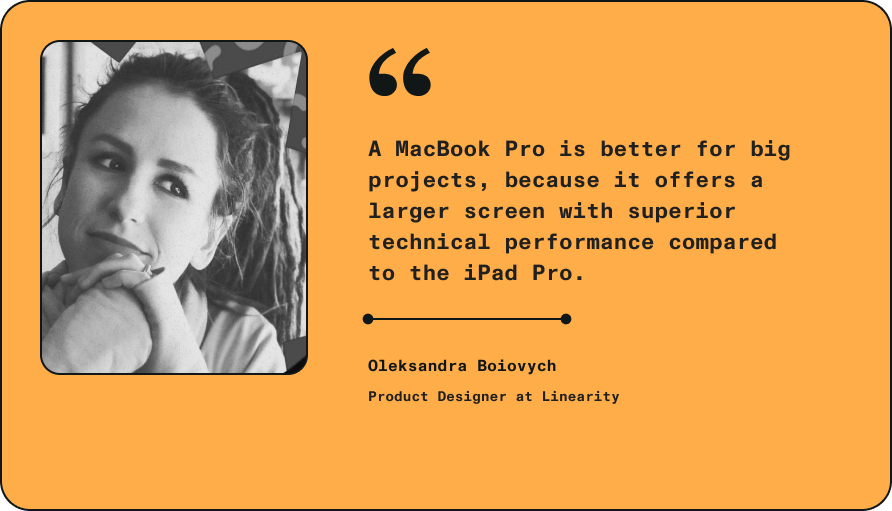
iPad Pro pros:
- Perfect for hand drawing with Apple Pencil, so it’s the best for illustrations.
- Portable, suited for quick editing on the go.
iPad Pro cons:
- Difficult font management and installing new fonts.
- Small screen for projects that have many artboards or frames.
- Only 1–2 software programs can be used at the same time.
MacBook Pro pros:
- Better for big projects, because it offers a larger screen with superior technical performance.
- Much more professional products available for Mac.
- Different tools can be used easily.
- You can connect a monitor.
MacBook Pro cons:
- Only if you want to carry it, it’s bigger and less convenient for drawing.
- So depends on the task, if you need to draw an illustration. iPad is a good choice. For any other tasks I would work on Mac.
Sam Eckert, Design, Product & Strategy Lead at Linearity
Formerly a tech copywriter, independent iOS developer, and marketing agency Founder, Sam's insights as Linearity's strategic Design & Product Lead are invaluable.
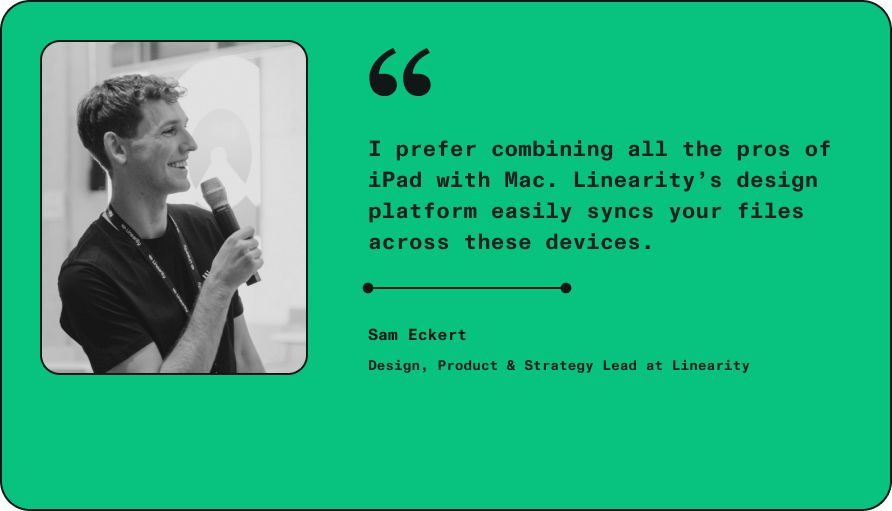
Here's what he had to say about using iPad Pro vs MacBook Pro for graphic design:
"Generally, I agree with everything my amazing teammates said ahead of me.
"I’d like to highlight that using both devices in companion is obviously a best-case scenario, as it combines all the pros of iPad and Mac.
"And if you use Linearity, all your files are easily synced and available across all devices."
We tend to agree with Sam. With so many device options and incredible pros to both formats (touchscreen or laptop), it seems that a combination of both would benefit any graphic designer.
Whether you're a web or app designer creating responsive displays, or a graphic designer wanting to animate social media assets, device flexibility is a win.
Let's take a deep dive into the pricing, specifications, and features of the iPad and MacBook models. Then, we'll compare the two and share our final verdict.
Compare Apples with Apples: iPad and MacBook models
iPads
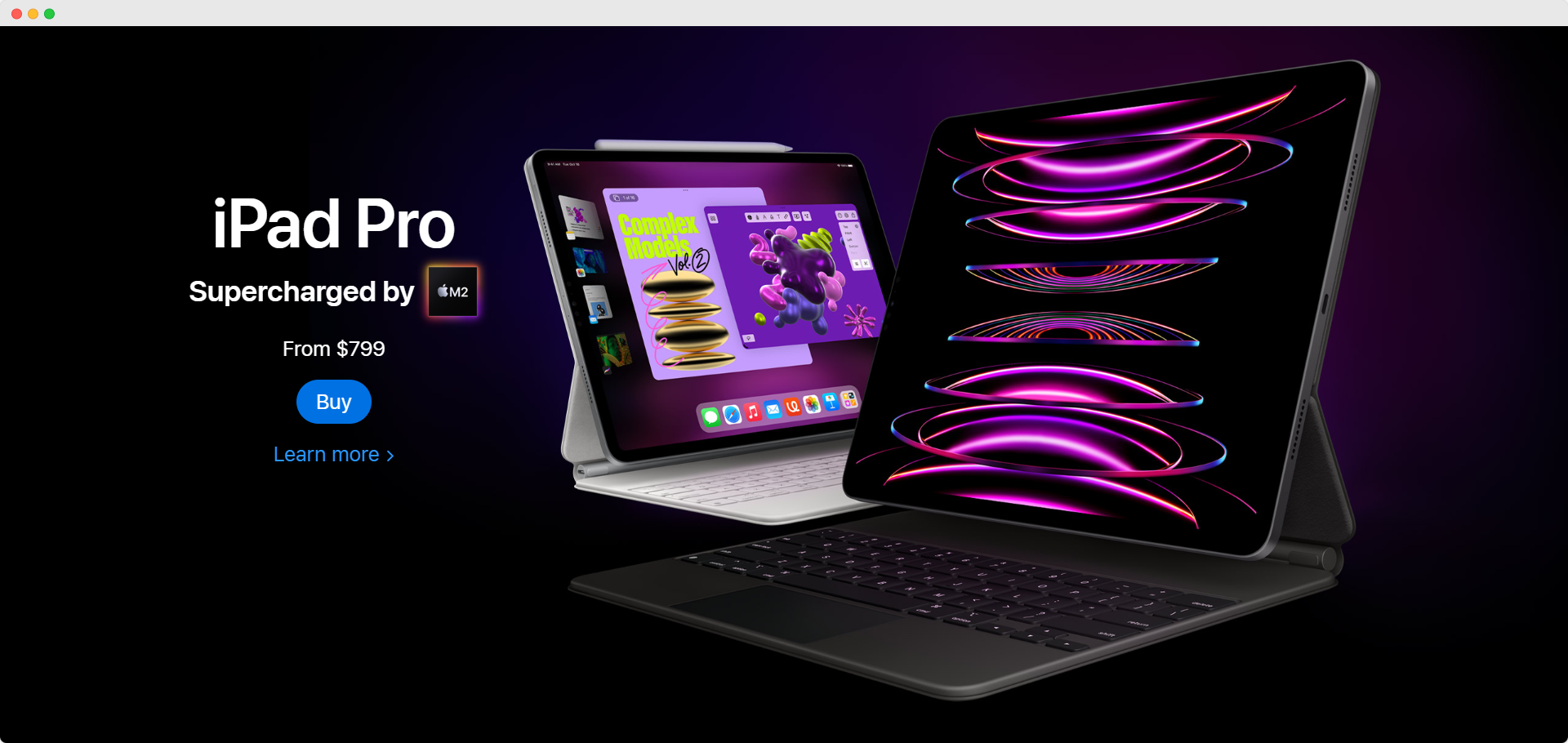
Let's look at the differences in screen size and quality of the various iPad models available. We'll also consider the processing power, camera capabilities, and accessory compatibility, such as Apple's Pencil and keyboards.
Check out the table below that highlights the key features to consider when choosing an iPad as a creative tool.
| Feature | iPad Pro | iPad Air | iPad (10th generation) | iPad (9th generation) | iPad mini |
|---|---|---|---|---|---|
| Starting price | $799 | $599 | $449 | $329 | $499 |
| Screen size | 12.9″ or 11″ | 10.9″ | 10.9″ | 10.2″ | 8.3″ |
| Display type | Liquid Retina XDR (12.9") or Liquid Retina (11") | Liquid Retina | Liquid Retina | Retina | Liquid Retina |
| Display features | ProMotion, P3 wide color, Antireflective coating | P3 wide color, Antireflective coating | sRGB color | sRGB color | P3 wide color, Antireflective coating |
| Chip | M2 | M1 | A14 Bionic | A13 Bionic | A15 Bionic |
| CPU | 8-core | 8-core | 6-core | 6-core | 6-core |
| GPU | 10-core | 8-core | 4-core | 4-core | 5-core |
| Storage | Up to 2TB | Up to 256GB | Up to 256GB | Up to 256GB | Up to 256GB |
| Battery life | Up to 10 hours | Up to 10 hours | Up to 10 hours | Up to 10 hours | Up to 10 hours |
| Front camera | 12MP Ultra Wide, TrueDepth system | 12MP Ultra Wide | Landscape 12MP Ultra Wide | 12MP Ultra Wide | 12MP Ultra Wide |
| Rear camera | 12MP Wide, 10MP Ultra Wide | 12MP Wide | 12MP Wide | 8MP Wide | 12MP Wide |
| Video capability | 4K, ProRes | 4K | 4K | 1080p | 4K |
| Connector type | USB‑C with Thunderbolt (USB4) | USB‑C | USB‑C | Lightning | USB‑C |
| Apple Pencil compatibility | 2nd Generation, USB‑C | 2nd Generation, USB‑C | USB‑C, 1st Generation | 1st Generation | 2nd Generation, USB‑C |
| Keyboard compatibility | Magic Keyboard | Magic Keyboard | Magic Keyboard Folio | Smart Keyboard | Bluetooth keyboards |
We've created a few categories and selected a winner for each one. This may help you choose the right iPad for your particular use case and image processing needs.
High-end performance and display: iPad Pro
- Best for: Professionals who need the most advanced technology for detailed and complex design work.
- Key features: Offers the largest screen options (12.9″ or 11″) with the most superior display technologies like Liquid Retina XDR (on the 12.9" model) and ProMotion, ensuring crisp, vibrant visuals with smooth scrolling and animation. The M2 chip provides unparalleled performance for the most demanding tasks, from graphic design to video editing.
- Why choose: If your work involves extensive use of color and detail, or if you're often working with resource-intensive applications, the iPad Pro is unmatched. Its support for the 2nd generation Apple Pencil and Magic Keyboard enhances precision and flexibility in design workflows.
Versatile performer: iPad Air
- Best for: Designers who need powerful performance in a more portable and affordable package.
- Key features: Features a 10.9″ Liquid Retina display with P3 wide color and antireflective coating, ensuring good color accuracy and visibility. The M1 chip offers robust performance that can handle most graphic design tasks efficiently.
- Why choose: The iPad Air strikes a balance between performance and portability, making it ideal for designers on the go. It’s a solid choice if you want a device that performs well for design tasks without the iPad Pro's premium.
Budget-friendly and versatile: iPad (10th generation)
- Best for: Entry-level graphic designers and students looking for an all-around device.
- Key features: Shares the same screen size as the iPad Air but opts for the A14 Bionic chip, balancing cost and performance. While it lacks some of the advanced display features, it's still a competent device for design work.
- Why choose: If budget is a concern but you still need a capable device for design work, this iPad offers a great starting point. It’s also versatile enough to handle everyday tasks beyond design.
Most affordable option: iPad (9th generation)
- Best for: Designers needing an iPad for basic design tasks and personal use.
- Key features: Offers a Retina display and the A13 Bionic chip, which are sufficient for basic graphic design tasks and digital sketching. It’s the most affordable iPad, making it accessible for beginners or as a secondary device.
- Why choose: For those new to digital art or graphic design, or if you're seeking the most budget-friendly entry into the iPad ecosystem, this model presents the lowest barrier to entry.
Ultra-portable design: iPad mini
- Best for: Designers who prioritize portability and sketching on the go.
- Key features: The smallest option available, with an 8.3″ Liquid Retina display and A15 Bionic chip. Despite its size, it doesn't compromise on performance and screen quality, supporting P3 wide color and offering an antireflective coating.
- Why choose: Ideal for sketching, jotting down ideas, and staying productive while traveling. Its compact size makes it the perfect companion for designers who want creativity at their fingertips, anywhere.
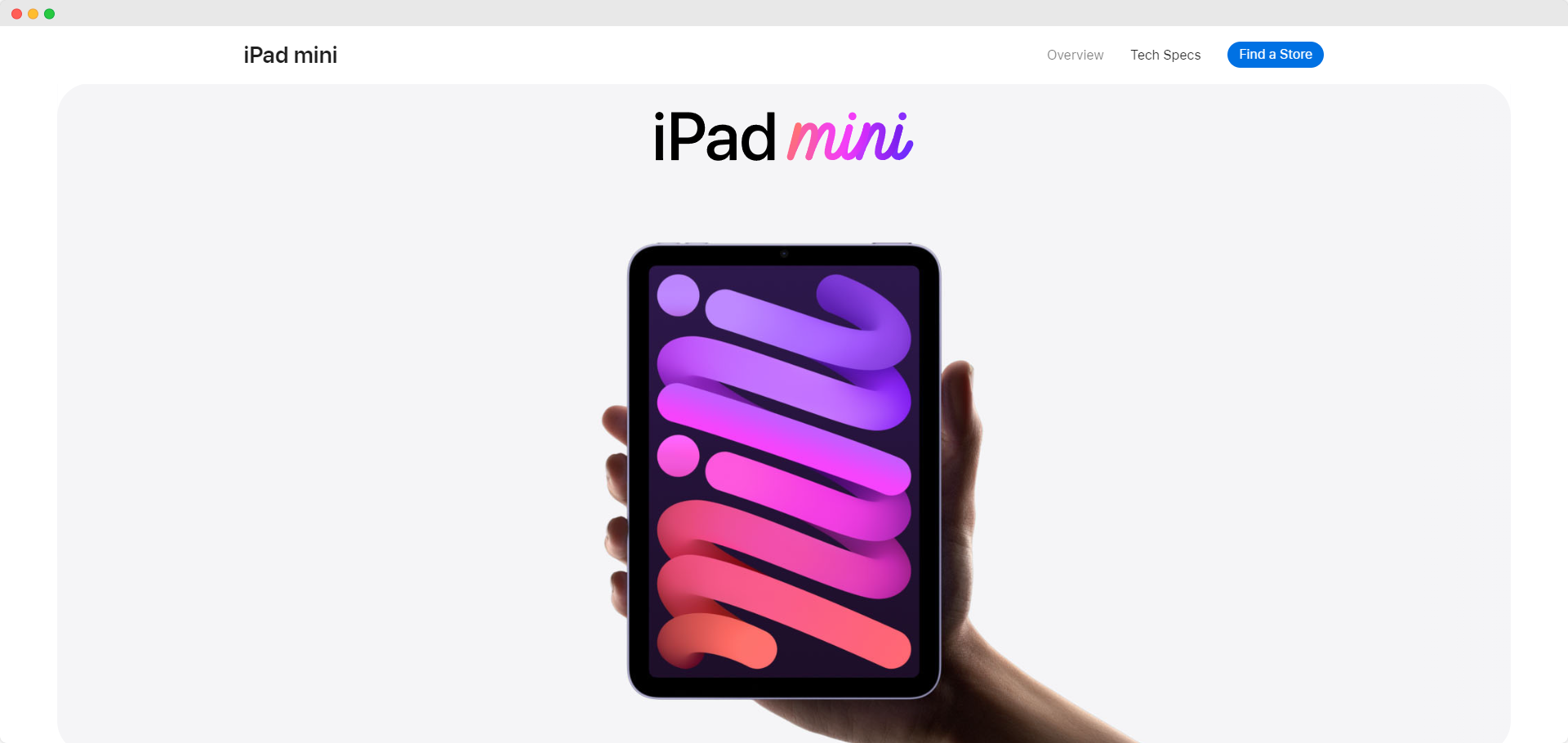
Now that you've analyzed the huge range of iPad options to choose from, let's compare the MacBooks.
MacBooks
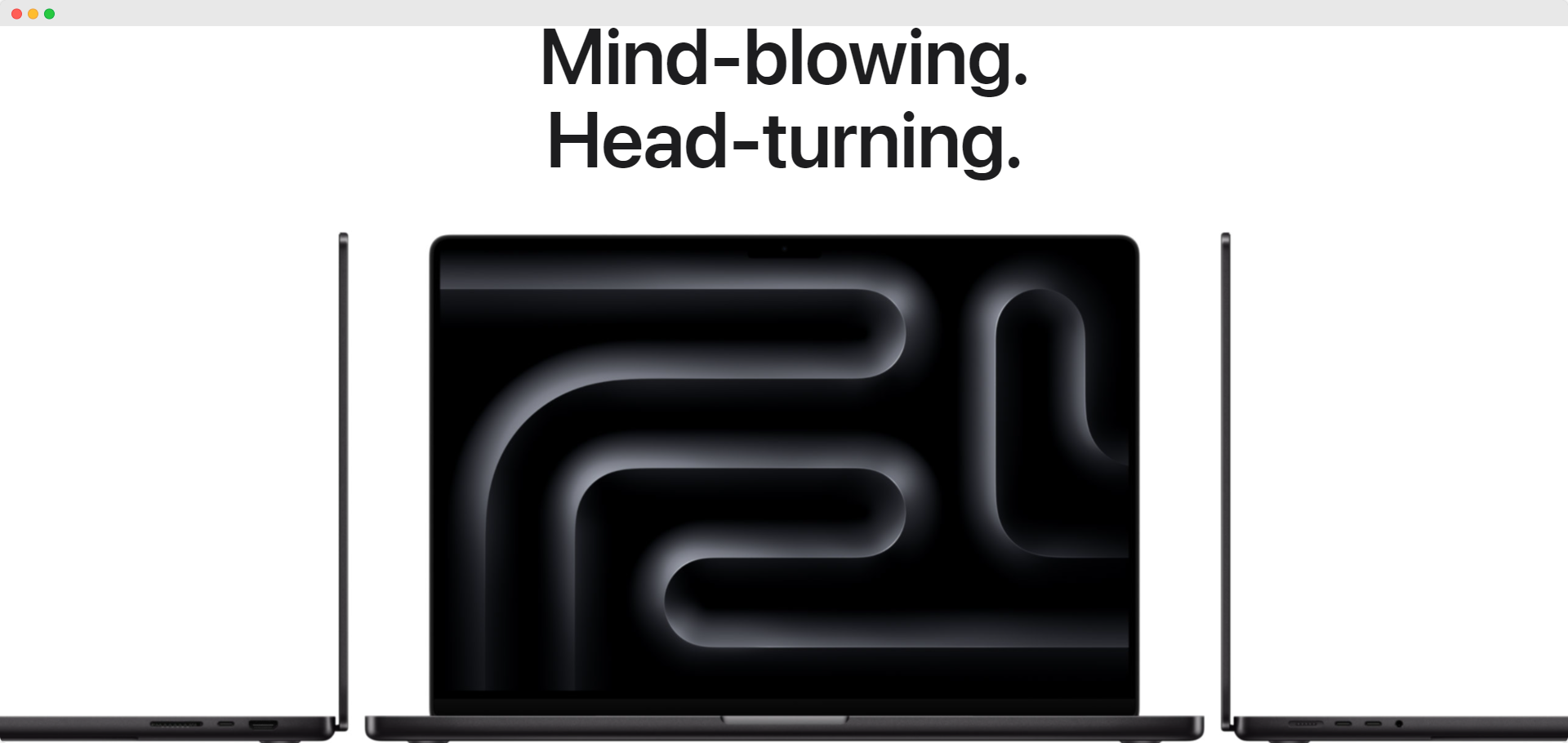
| Feature | MacBook Pro 14-in. (M3) | MacBook Pro 14-in. (M3 Pro/M3 Max) | MacBook Pro 16-in. (M3 Pro/M3 Max) | MacBook Air 13-in. (M2) | MacBook Air 13-in. (M1) | MacBook Air 15-in. (M2) |
|---|---|---|---|---|---|---|
| Starting price | $1599 | $1999 | $2499 | $1099 | $999 | $1299 |
| Display | 14.2” Liquid Retina XDR | 14.2” Liquid Retina XDR | 16.2” Liquid Retina XDR | 13.6” Liquid Retina | 13.3” Retina | 15.3” Liquid Retina |
| Chip | M3 | M3 Pro or M3 Max | M3 Pro or M3 Max | M2 | M1 | M2 |
| CPU | 8-core | Up to 16-core | Up to 16-core | 8-core | 8-core | 8-core |
| GPU | 10-core | Up to 40-core | Up to 40-core | Up to 10-core | 7-core | 10-core |
| Storage | Up to 2TB | Up to 8TB | Up to 8TB | Up to 2TB | Up to 2TB | Up to 2TB |
| Battery life | Up to 22 hrs | Up to 18 hrs | Up to 22 hrs | Up to 18 hrs | Up to 18 hrs | Up to 18 hrs |
| Trackpad | Force Touch | Force Touch | Force Touch | Force Touch | Force Touch | Force Touch |
| Camera | 1080p FaceTime HD | 1080p FaceTime HD | 1080p FaceTime HD | 1080p FaceTime HD | 720p FaceTime HD | 1080p FaceTime HD |
| Ports | Three Thunderbolt 4 (USB-C), HDMI, SDXC | Three Thunderbolt 4 (USB-C), HDMI, SDXC | Three Thunderbolt 4 (USB-C), HDMI, SDXC | Two Thunderbolt (USB4) | Two Thunderbolt (USB4) | Two Thunderbolt (USB4) |
| Video Capability | Support for up to 6K resolution at 60Hz | Support for up to 6K resolution at 60Hz | Support for up to 6K resolution at 60Hz | Support for 1 external display up to 6K at 60Hz | Support for 1 external display up to 6K at 60Hz | Support for 1 external display up to 6K at 60Hz |
Given the comprehensive details about the various MacBook models, let's break down the key points that matter most to graphic designers:
Display and performance
For high-resolution graphic work, the MacBook Pro models with their Liquid Retina XDR displays offer superior visual clarity, color accuracy, and brightness.
The M3 Pro and M3 Max chips in the MacBook Pro models provide the processing power necessary for intensive design tasks, supporting up to 40-core GPU configurations for smooth rendering of complex graphics.
Portability vs power
The MacBook Air models, while more portable and cost-effective, offer impressive performance for many graphic design tasks thanks to the M1 and M2 chips.
The 13-inch models are more than capable of handling design work on the go, but for more demanding tasks, the 15-inch MacBook Air with M2 chip offers a balance between screen real estate and portability.
Memory and storage options
Higher memory options in the MacBook Pro models (up to 128GB) accommodate heavy multitasking and large design files better than the MacBook Air's max 24GB memory.
Similarly, storage options are more expansive in the MacBook Pro line, with up to 8TB available, compared to the MacBook Air's maximum of 2TB.
This means that if you work with exceptionally large files or need to store an extensive library of resources on your device, the MacBook Pro is better equipped to meet those needs without requiring external storage solutions.
Keyboard and trackpad
The quality of the keyboard and trackpad is crucial for designers who rely on shortcuts and gestures to streamline their workflow. Both the MacBook Pro and MacBook Air feature the Magic Keyboard and Force Touch trackpad, known for their responsiveness and comfort.
But the MacBook Pro's slightly larger size may offer a more spacious keyboard layout, potentially benefiting those who spend extensive hours typing or using shortcuts in design software.
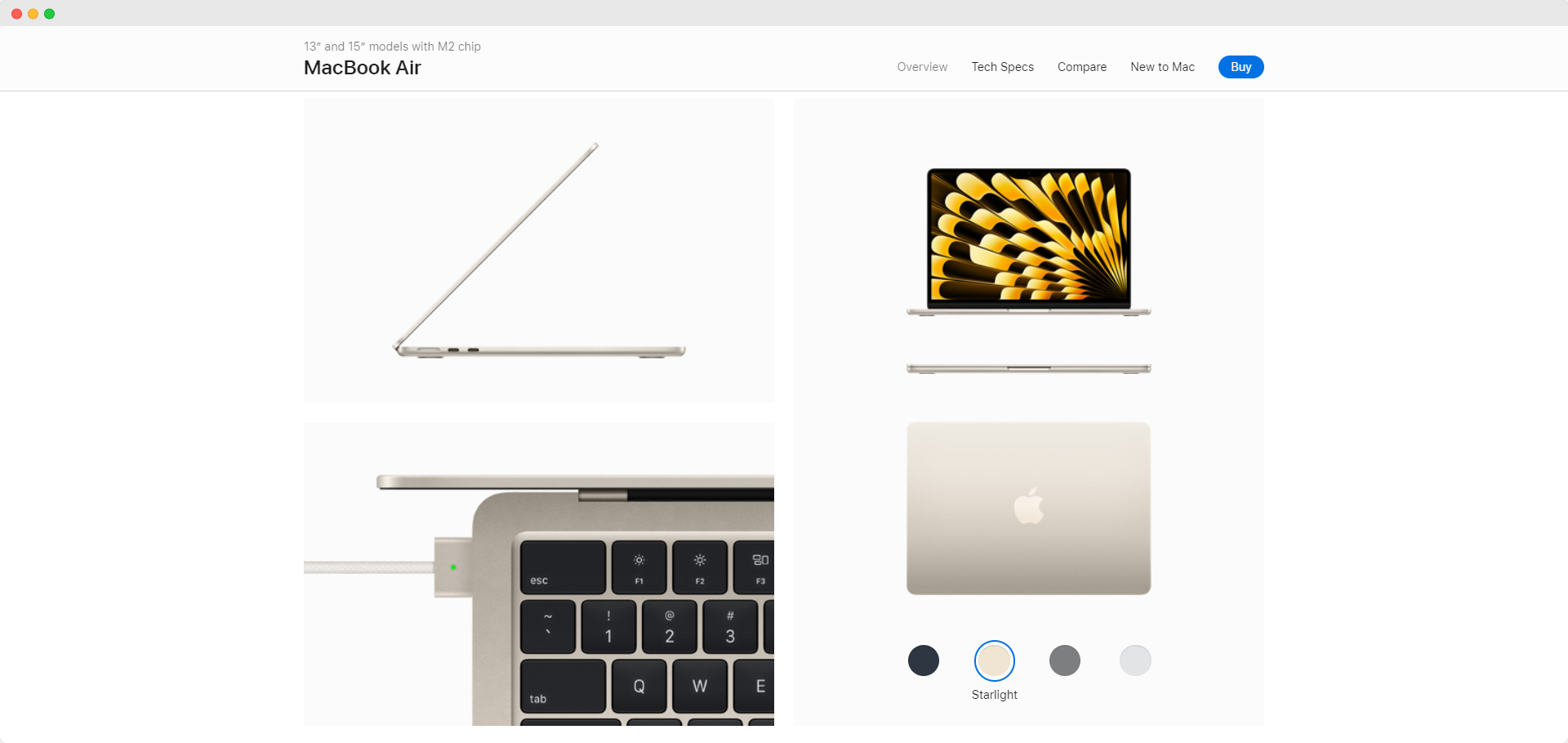
Video capability
For graphic designers who also engage in video editing or animation work, the MacBook Pro's support for up to 6K resolution on external displays at 60Hz is a significant advantage.
This capability allows for a more detailed and expansive workspace, which is beneficial when working on high-resolution projects or multitasking across multiple applications.
Check out the video below showing Linearity Move in use on a Mac:
Audio and camera
While not the primary concern for graphic design, the superior audio system in the MacBook Pro models might be beneficial for those who also work with multimedia content or enjoy high-quality sound while working.
The 1080p FaceTime HD camera across the newer MacBook models improves video call quality, which is useful for remote collaboration with clients or teams.
For graphic designers who want the utmost power, display quality, and multitasking capability, the MacBook Pro models stand out as the best choice. They offer the highest performance specs, the largest memory and storage capacities, and the best display technology—at a higher price point, of course.
On the other hand, the MacBook Air models, particularly the 15-inch version with the M2 chip, present a compelling option for designers seeking a balance between performance, portability, and price.
While they may not match the MacBook Pro's top-tier specs, MacBook Airs offer more-than-sufficient power for a wide range of graphic design tasks, plus the benefits of a lighter device at a lower cost.
Our verdict: is iPad Pro or MacBook Pro better for graphic design?
When it comes to equipping graphic designers within marketing teams with the best tools for their creative endeavors, the choice between an iPad Pro and a MacBook Pro is not just about selecting a device. It's about choosing a partner that aligns with your workflow, creativity, and productivity needs.
After considering the extensive capabilities of both the iPad Pro and MacBook Pro, it's clear that each device serves distinct roles that cater to different aspects of graphic design.
iPad Pro: With its touch screen and Apple Pencil support, the iPad Pro offers an unparalleled direct interaction with your creative work, making it ideal for sketching, conceptualizing ideas, and tactile graphic creation.
Its portability and camera features also enable you to capture inspiration on the go and immediately integrate these elements into your creative projects.
"The MacBook has more storage and adaptability. You can plug a webcam in and use it to stream, or use a camera and import video to your MacBook. You can’t use the Apple Pencil with the MacBook. So, for that, the iPad ‘wins.’"—Skydiver119 on Apple Community
MacBook Pro: On the other hand, the MacBook Pro stands out as the powerhouse for graphic design, especially for those within marketing teams dealing with complex projects that require intense processing power. These tasks could include video editing, 3D modeling, and handling large design files.
With its advanced M3 Pro and M3 Max chips, expansive memory and storage options, and superior Liquid Retina XDR display, the MacBook Pro is unmatched in its ability to execute demanding tasks efficiently. Its ecosystem also offers a broader range of professional software options crucial for in-depth editing, rendering, and publishing.
"The iPad Pro is great for drawing, but I recommend you go into a store and actually use one. They're wonderful devices, but they're not computers. So you best check to see if it'll be suitable for whatever else you need to do. I would not give up my computer, but I also have an iPad for art, reading books, and streaming movies to the big-screen TV."—Babowa on Apple Community
The best choice for graphic designers in marketing teams: Considering the dynamic and multifaceted nature of graphic design within marketing teams, the choice between an iPad Pro and a MacBook Pro ultimately hinges on your budget and design workflow.
- For designers who prioritize mobility, direct interaction with their creative work, and the convenience of a digital sketchpad, the iPad Pro is an excellent choice. It's particularly beneficial for brainstorming sessions, initial mock-ups, and presenting ideas to clients and team members.
- For those who require robust performance for high-fidelity graphics work, extensive multitasking, and running sophisticated design software, the MacBook Pro emerges as the clear winner. It's suited for the heavy lifting of graphic design, from intricate illustrations to complex marketing campaign materials.
This duo enables graphic designers to enjoy the best of both worlds: starting their creative process on the iPad Pro and refining their projects with the powerful capabilities of the MacBook Pro. Linearity's file storage makes it possible to seamlessly switch between these devices as you design and iterate.
Ultimately, understanding the unique requirements of your role within the marketing team and the nature of your projects will guide you to the right choice. Whether you lean towards the iPad Pro's interactive design experience or the MacBook Pro's robust performance, both devices stand as formidable tools that can take your graphic design work to a new level.
Have you tried our graphic design software suite? You can design in Linearity Curve and animate in just one click using Linearity Move—our paradigm-shifting animation software for marketing teams.
This powerful combo promises to reduce turnaround time and increase your marketing ROI. Try it for free below, and check out our launch discount for early adopters.
Frequently asked questions
Can I use an iPad for professional graphic design?
Yes, the iPad Pro is a formidable tool for professional graphic design, especially when paired with Linearity Curve. You can use the Apple Pencil with this intuitive vector design software to create social posts, video thumbnails, ads, product announcements, and more.
What are the best graphic design apps on iPad?
Linearity Curve stands out for vector design with its user-friendly interface and robust features, while Linearity Move offers unmatched versatility for on-the-go animation tasks.
How is the iPad Pro better than other iPad models for design?
Designed with professionals in mind, the iPad Pro features a larger screen, advanced processing capabilities, and enhanced Apple Pencil integration, making it a top choice for high-level graphic design.
What's the best iPad for design and sketching?
The best iPad for design and sketching is the iPad Pro, especially the latest model. Its large screen, high resolution, and compatibility with the Apple Pencil make it the preferred choice for all types of designers looking for precision and flexibility in their creative work.
Why shouldn't I use an iPad Pro and Apple Pencil for design?
While the iPad Pro and Apple Pencil are powerful tools for graphic design, there are scenarios where they might not be ideal.
For instance, if your workflow relies heavily on desktop-specific software that isn’t fully functional or available on iOS. Another example would be if you require advanced hardware capabilities for 3D modeling or intensive rendering that exceed the iPad's specs.

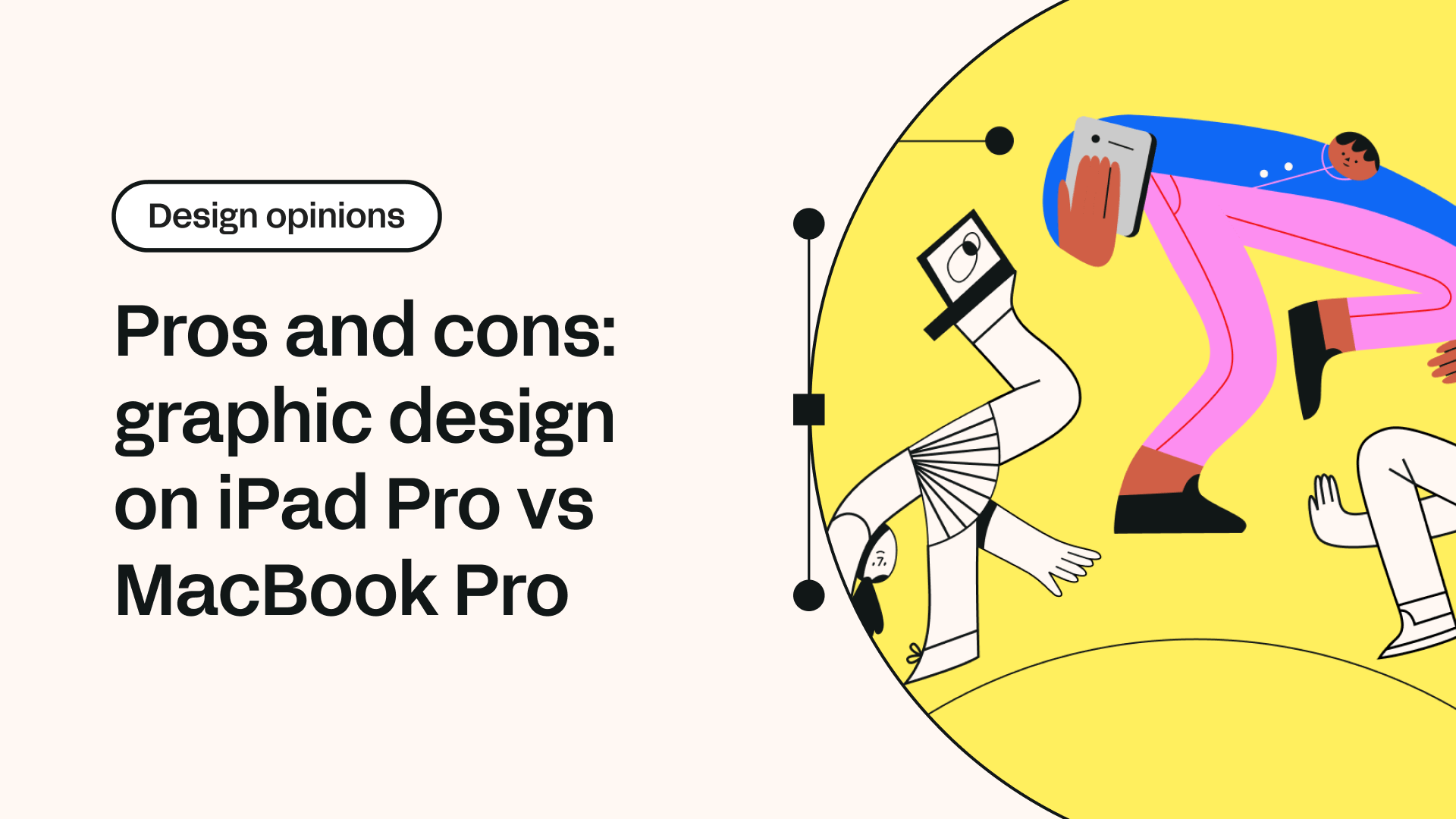
Share this!
Sharné McDonald
Sharné is a contributing writer to the Linearity Blog. She has 10+ years' experience in graphic design and marketing and holds a Master's degree in Art Education.


:quality(75))
:quality(75))



:quality(75))

:quality(75))
:quality(75))



